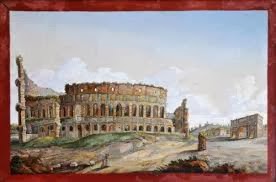Un'arte antica: il micromosaico. An ancient art: the micro-mosaic.
Verso la fine del 1700, a Roma, presso il Vaticano, viene inventata una tecnica per fare opere in mosaico di piccole dimensioni: Per poter fare copie precise, e preziose, delle opere d'arte presenti in Vaticano. Lo scopo era quello di vendere queste copie ai visitatori (soprattutto stranieri) che sempre più numerosi arrivavano a Roma . Essi chiedevano di portare nel loro Paese una copia delle grandi opere d'arte create da artisti come Raffaello, Michelangelo ecc. oppure di paesaggi della Roma antica.
Questa tecnica consisteva nel creare una pasta vitrea, formata da silicio fuso mescolato con ossidi metallici. Dopo la fusione questa pasta veniva filata e, dopo il raffreddamento, tagliata in tessere minute di due o tre millimetri di lato. Questa pasta vitrea poteva avere una gamma notevole di colori. Queste minute tessere venivano poi inserite in una pasta a base di creta e olio, per formare opere di forma spesso anche ridottissima. Oltre creare copie di opere famose, la tecnica del micromosaico può essere utilizzata per creare gioielli molto preziosi. In questo caso la parte di micromosaico può diventare l'incastonatura per il gioiello. Possono essere utilizzati metalli preziosi per creare il gioiello: argento, oro, platino ecc. Ma anche i metalli meno preziosi, come il rame, il bronzo, l'acciaio possono acquistare nuova preziosità se accoppiati al micromosaico. Oggi questa tecnica purtroppo non è più molto utilizzata, per creare gioielli, ma, quando possiamo ammirare alcuni di questi spesso capiamo che siamo di fronte a vere e proprie opere d'arte.
Towards the end of 1700, in Rome, at the Vatican, is invented a technique to make works in mosaic small : In order to make exact copies , and valuable works of art in the Vatican. The purpose was to sell these copies to visitors ( especially foreign ) that more and more came to Rome . They asked to bring in their own country a copy of the great works of art created by artists such as Raphael, Michelangelo, and so on. or landscapes of ancient Rome.
This technique was to create a glass-paste , made from fused silica mixed with metal oxides. After melting this pulp was spun and , after cooling , cut into minute pieces of two or three millimeters wide. This glass paste could have a remarkable range of colors. These minute pieces were then placed in a paste made of clay and oil, to form works of form often very low . Apart from making copies of famous works , the technique can be used to create micro-mosaic jewelry very valuable. In this case, the part of micro-mosaic can become embedding for the jewel . They can be used to create the precious metal jewelry : silver, gold, platinum etc. . But even the less precious metals , such as copper , bronze , steel can buy new preciousness if coupled to the micro-mosaic . Today this technique is unfortunately no longer widely used , to create jewelry, but when we see some of these often we understand that we are dealing with true works of art.
Panorama di Roma - Micromosaico '700 - Foto da Internet
Questa tecnica consisteva nel creare una pasta vitrea, formata da silicio fuso mescolato con ossidi metallici. Dopo la fusione questa pasta veniva filata e, dopo il raffreddamento, tagliata in tessere minute di due o tre millimetri di lato. Questa pasta vitrea poteva avere una gamma notevole di colori. Queste minute tessere venivano poi inserite in una pasta a base di creta e olio, per formare opere di forma spesso anche ridottissima. Oltre creare copie di opere famose, la tecnica del micromosaico può essere utilizzata per creare gioielli molto preziosi. In questo caso la parte di micromosaico può diventare l'incastonatura per il gioiello. Possono essere utilizzati metalli preziosi per creare il gioiello: argento, oro, platino ecc. Ma anche i metalli meno preziosi, come il rame, il bronzo, l'acciaio possono acquistare nuova preziosità se accoppiati al micromosaico. Oggi questa tecnica purtroppo non è più molto utilizzata, per creare gioielli, ma, quando possiamo ammirare alcuni di questi spesso capiamo che siamo di fronte a vere e proprie opere d'arte.
Towards the end of 1700, in Rome, at the Vatican, is invented a technique to make works in mosaic small : In order to make exact copies , and valuable works of art in the Vatican. The purpose was to sell these copies to visitors ( especially foreign ) that more and more came to Rome . They asked to bring in their own country a copy of the great works of art created by artists such as Raphael, Michelangelo, and so on. or landscapes of ancient Rome.
Anello in micromosaico ed argento - Gioiello di Angelo Vignolo - Foto di Angelo Vignolo 2011
Anello in micromosaico ed oro in foggia antica - Foto da internet
Pendente in micromosaico ed argento - Gioiello di Angelo Vignolo - Foto di Angelo Vignolo 2011





